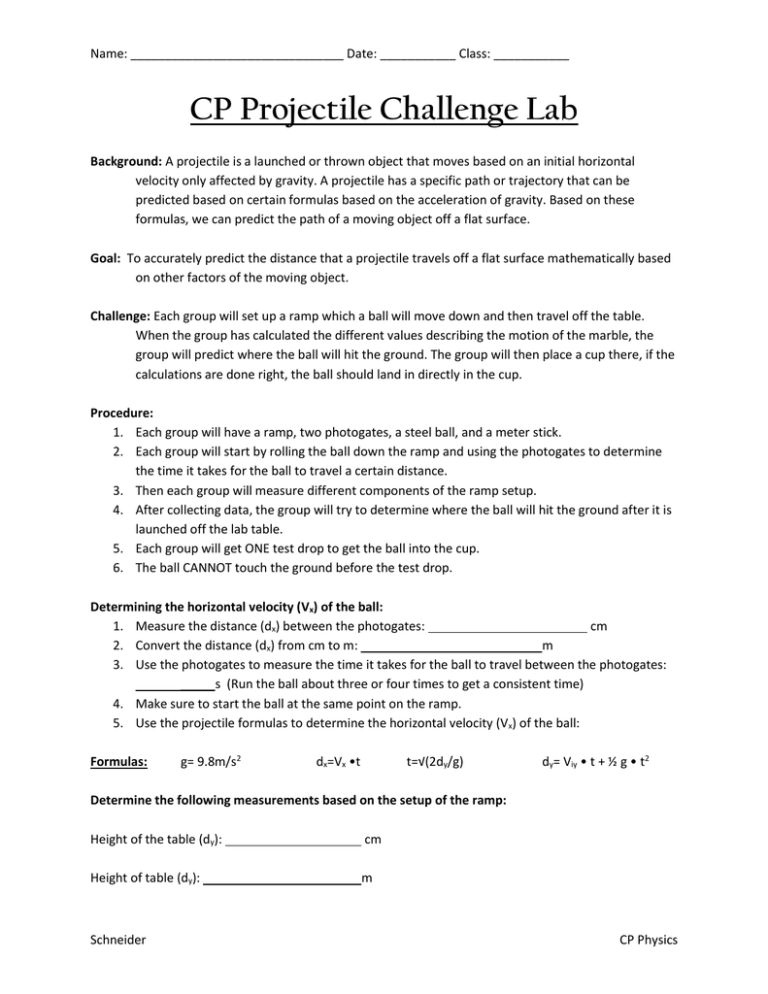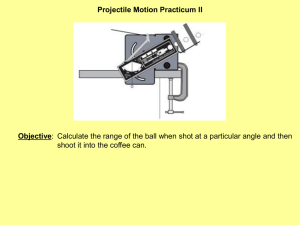CP Projectile Challenge Lab
advertisement

Name: _______________________________ Date: ___________ Class: ___________ CP Projectile Challenge Lab Background: A projectile is a launched or thrown object that moves based on an initial horizontal velocity only affected by gravity. A projectile has a specific path or trajectory that can be predicted based on certain formulas based on the acceleration of gravity. Based on these formulas, we can predict the path of a moving object off a flat surface. Goal: To accurately predict the distance that a projectile travels off a flat surface mathematically based on other factors of the moving object. Challenge: Each group will set up a ramp which a ball will move down and then travel off the table. When the group has calculated the different values describing the motion of the marble, the group will predict where the ball will hit the ground. The group will then place a cup there, if the calculations are done right, the ball should land in directly in the cup. Procedure: 1. Each group will have a ramp, two photogates, a steel ball, and a meter stick. 2. Each group will start by rolling the ball down the ramp and using the photogates to determine the time it takes for the ball to travel a certain distance. 3. Then each group will measure different components of the ramp setup. 4. After collecting data, the group will try to determine where the ball will hit the ground after it is launched off the lab table. 5. Each group will get ONE test drop to get the ball into the cup. 6. The ball CANNOT touch the ground before the test drop. Determining the horizontal velocity (Vx) of the ball: 1. Measure the distance (dx) between the photogates: cm 2. Convert the distance (dx) from cm to m: m 3. Use the photogates to measure the time it takes for the ball to travel between the photogates: _____s (Run the ball about three or four times to get a consistent time) 4. Make sure to start the ball at the same point on the ramp. 5. Use the projectile formulas to determine the horizontal velocity (Vx) of the ball: Formulas: g= 9.8m/s2 dx=Vx •t t=√(2dy/g) dy= Viy • t + ½ g • t2 Determine the following measurements based on the setup of the ramp: Height of the table (dy): cm Height of table (dy): m Schneider CP Physics Name: _______________________________ Date: ___________ Class: ___________ Based on the data above, determine the distance between the edge of the table and the spot where the ball will hit the ground (Horizontal distance or dx): Hint: dx and dy are not directly related so you may have to find something that can relate to both of them. Conclusion Questions: 1) When the ball leaves the table, what is the only vertical force acting on the ball? 2) Will each groups time it takes for the ball to hit the ground be the same even if they start at different points on the ramp? Explain: 3) Does it matter when the horizontal velocity of the ball is measured? Why or why not? 4) Will each groups distance from the table be the same if they start the ball at different places on the ramp? Explain: 5) What are some potential sources of error in this challenge/experiment? Schneider CP Physics





